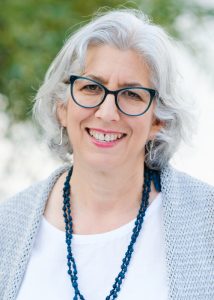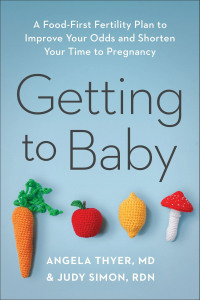In recent years, infertility has become a more pressing issue around the world. The World Health Organization now reports 1 out of 6 couples worldwide struggle with fertility issues.

According to Judy Simon, MS, RDN, CD, a clinical nutrition instructor at HSPop and a clinician at UW Women’s Health Center who also has a private practice as a registered dietician, the stigma surrounding infertility persists. Simon’s new book, Getting To Baby: A Food-First Fertility Plan To Improve Your Odds And Shorten Your Time To Pregnancy, offers practical, scientifically grounded advice for hopeful parents-to-be. The Whole U will host a virtual book launch and Q&A on Thursday, April 25th, coinciding with National Infertility Awareness Week.
Simon’s interest in fertility began when she and her co-author Angela Thyer, a reproductive endocrinologist and gynecologist, began working with women with conditions like polycystic ovary syndrome. When she started her own private practice, Simon decided to specialize in fertility. New research was also an inspiration: In 2009, Harvard researchers published a book based on their groundbreaking study of 20,000 nurses seeking to become pregnant, which found strong correlations between diet and fertility. For instance, replacing soda with water was found to improve fertility.
Simon created a class called Food For Fertility, which she and Thyer operated for 12 years. These classes created community and reached a diverse range of parents, including same-sex couples and single mothers. Those success stories became the core of the book, meant to provide inspiration to readers.
Simon explains, “My idea was, what if instead of just telling people ‘Eat healthier,’ we as a group learned about folate and leafy green vegetables, and we would make a massaged kale salad or a kale soup? My idea, building on my public health background, was how can you help increase their self-efficacy, their confidence that they have the skills to be able to promote this healthy lifestyle that could help with fertility? We would cook, we would learn, we would share support, we would always do some stretching, and we would walk outside for half an hour, rain or shine. The women could talk together, get to know each other, getting that support that they weren’t the only one struggling on this fertility journey. We tracked these groups, and women were really getting pregnant, and some of them either didn’t have to go through IVF or IUI because they were able to use lifestyle modifications to make that change.”

According to correlational studies as well as Simon’s experiences with patients, prospective parents should cut down on red meat and processed foods while eating more of the whole grains, fruits and vegetables, and fish typical of a Mediterranean diet. These foods are nutrient-rich, high in fiber, and full of antioxidants. Meanwhile, substances like alcohol, caffeine, and cannabis can harm fertility. Rather than making blanket prohibitions, Simon provides tasty recipes with the hopes that by prioritizing fertility-boosters, people will find themselves naturally cutting down on fertility-disruptors.
Simon also notes that while women typically bear the brunt of fertility treatment, men have their own role to play. Low sperm count or low-quality sperm can affect the probability of conception, and there’s data showing that men’s diets affect their fertility. Simon hopes her book can be helpful for all genders and sexualities.
Her advice is also accessible for all income levels. The point isn’t to spend more on groceries from a pricier grocery source, but to go back to the Pescatarian basics, which can often save money in the long run.
“A of people think that they have to eat all organic food, we’re like, ‘No, you need to eat fruits and vegetables,’” Simon explains. “In a perfect world, it’s great if it’s local, [because] local produce is going to be very nutritious. But the most important thing is eating the food.”
“We also want to recognize people’s budgets, and we really feel that since we’re more plant-forward and encouraging people to use beans and legumes and lentils and tofu as protein sources, that you could actually be saving money. We’re not telling people to try crazy supplements, [it’s] really focusing on the food and the lifestyle to help people to get to their baby. We like to say, ‘Get to your baby through the kitchen.’ I’m already getting feedback from people reading the book, and they’re like, ‘Oh my, not only does my husband like to replicate the recipes, my mom is cooking all of them, and she’s getting healthier!’”
Simon’s empathy for patients also comes from her own experience dealing with fertility issues before starting her family, and feeling that there were very few resources available, leaving her “really frustrated, isolated, and alone.” Now, she’s aiming to recreate the supportive, hopeful, pragmatic atmosphere of her Food For Fertility classes, only in book form.
“Everyone deserves to start a family,” she reflects.